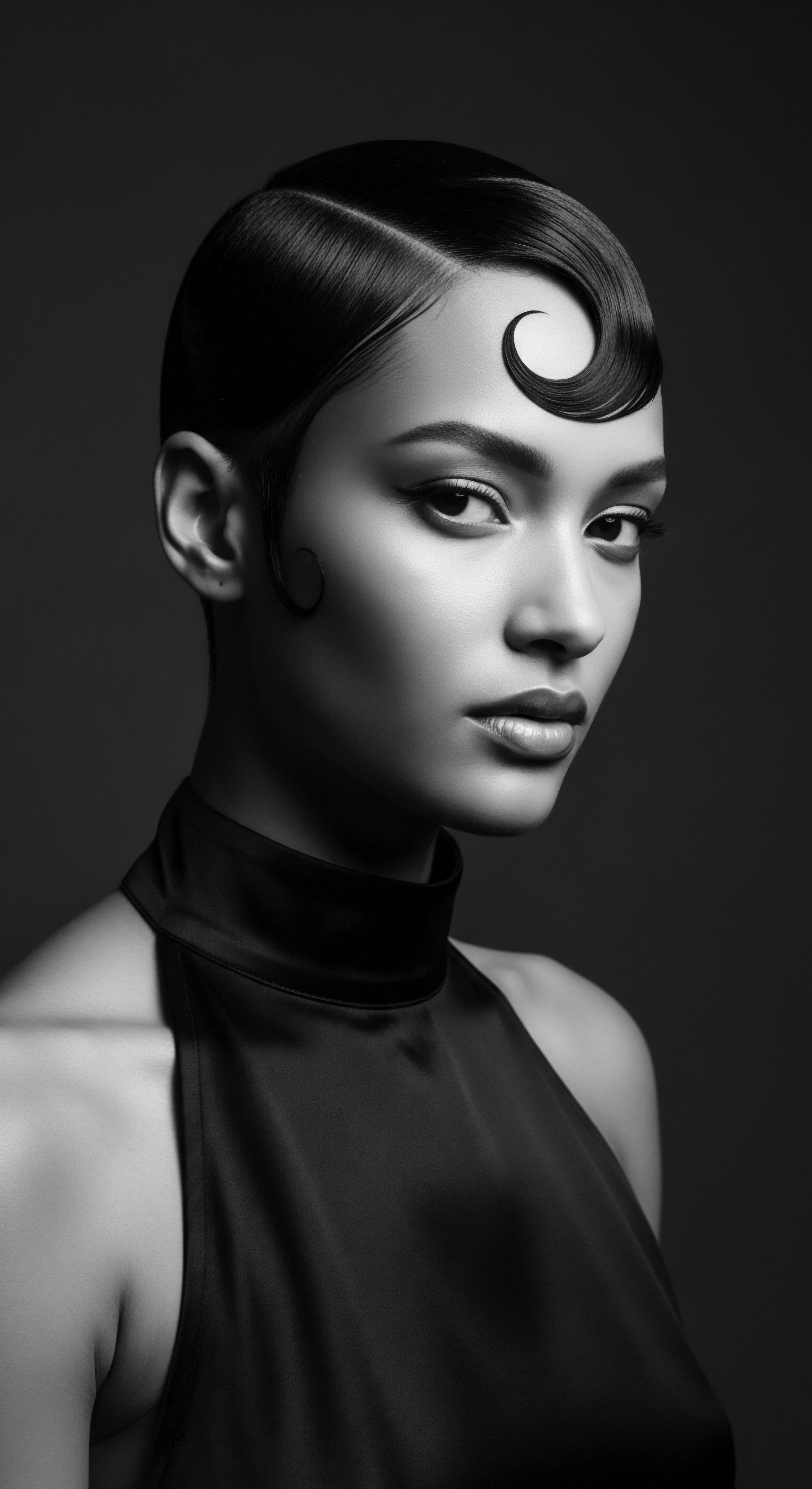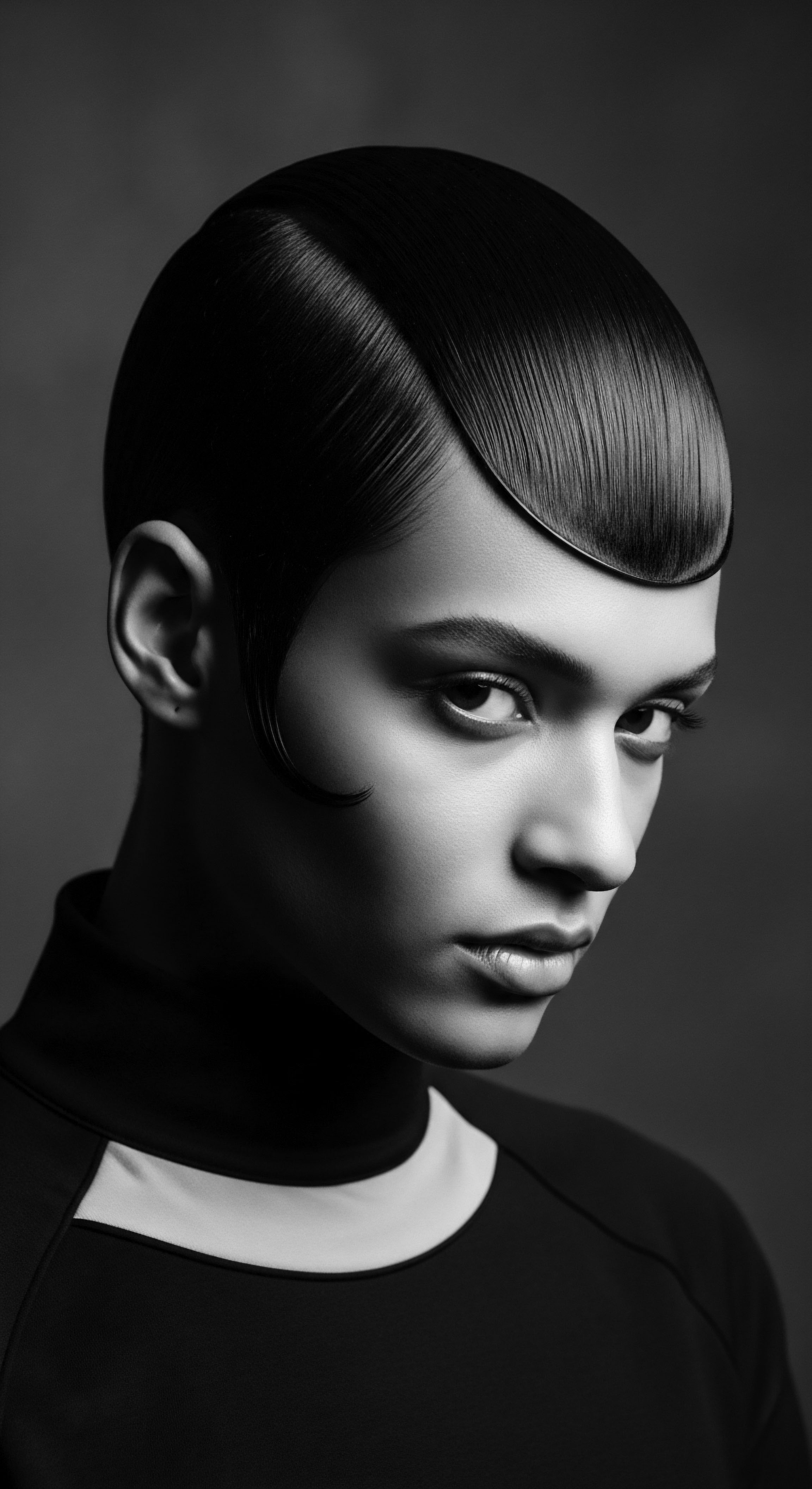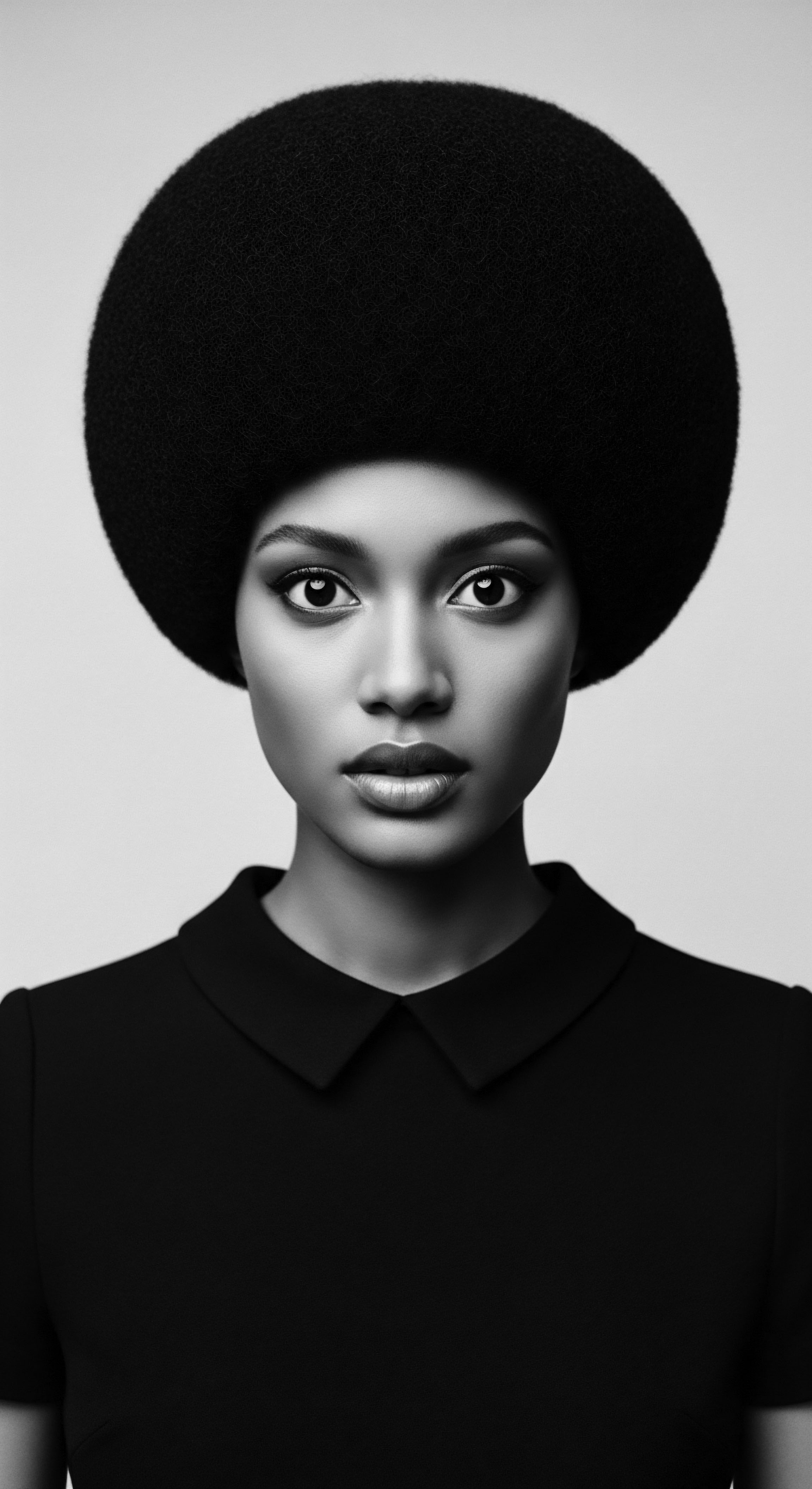
Roots
The strands that crown us carry stories, whispered across generations, etched into the very helix of our being. For those with textured hair, this inheritance is particularly profound, a living archive of resilience, beauty, and adaptive ingenuity. Consider the humble bonnet, seemingly a simple accessory, yet within its soft folds lies a wealth of historical significance, deeply connected to the legacy of textured hair. This exploration does not just recount facts; it seeks to listen to the echoes from the source, to feel the gentle pull of ancestral wisdom that shaped its place in our hair care traditions.
It invites a thoughtful look at how this seemingly unassuming fabric became, over centuries, a silent sentinel of hair health, a marker of identity, and a testament to enduring spirit. We look to the past, not with a distant gaze, but with an intimacy that brings forward the practical genius and profound cultural meanings embedded within this cherished item.

What is Textured Hair’s Ancestral Structure?
Textured hair, encompassing a magnificent spectrum from waves to tight coils, possesses a unique architecture. Its elliptical cross-section, paired with varied curl patterns, determines its distinct characteristics. Unlike straight hair, which tends to have a rounder cross-section, the flattened oval shape of a textured strand creates inherent points of vulnerability at each curve of the curl.
These bends and twists, while offering remarkable volume and style versatility, also make textured hair naturally prone to dryness and friction-related damage. The outer layer, the cuticle, which functions as a protective shield, lifts more readily at these curves, allowing moisture to escape and making the strand susceptible to external aggressors.
From an ancestral view, communities understood these innate qualities through observation and generations of practice. They recognized the need for care that honored this unique structure, often developing rituals that minimized manipulation and maximized protection. The very act of gathering hair, wrapping it, and shielding it reflected an intuitive scientific understanding, a wisdom passed down through touch and tradition. These early practices were not merely cosmetic; they were deeply practical responses to environmental conditions and the intrinsic biology of textured hair, ensuring its vitality and length retention.

How does Hair Anatomy Relate to Historical Care?
The physiology of textured hair, with its propensity for moisture loss and fragility at the cuticle, directly informed historical care practices. The scalp’s natural oils, sebum, travel less efficiently down the spiraled length of a coiled strand compared to a straight one. This means textured hair is often naturally drier at the ends, requiring consistent external moisture and protection to guard against breakage. Ancient cultures, long before the advent of modern microscopy, recognized these challenges.
They devised systems of care that revolved around preservation and gentle handling. This recognition led to the widespread adoption of head coverings, long before the term “bonnet” was universally applied. Such coverings served as a physical barrier against environmental elements like sun, wind, and dust, all of which contribute to moisture depletion and mechanical stress on hair.
Beyond environmental defense, these early head coverings also served a crucial role in maintaining hairstyles, extending their wear, and thus reducing the frequency of manipulative styling, which can cause strain on delicate strands. This practice speaks to an ancient understanding of low-manipulation principles, a core tenet of care for fragile hair. It highlights a continuity of purpose, where ancestral wisdom aligns with modern scientific understanding regarding the best ways to preserve textured hair’s health.
The historical significance of bonnets for textured hair rests in their enduring role as guardians of strand integrity and cultural expression.
| Historical Care Principle Minimizing daily manipulation |
| Modern Scientific Link Reduces mechanical stress and breakage on cuticle layer. |
| Historical Care Principle Utilizing protective coverings |
| Modern Scientific Link Shields hair from environmental dryness and physical friction. |
| Historical Care Principle Relying on natural oils and emollients |
| Modern Scientific Link Supplements natural sebum distribution, countering inherent dryness. |
| Historical Care Principle Ancestral methods often mirrored contemporary scientific principles for maintaining textured hair vitality. |

Ritual
The story of the bonnet, as it winds through the experience of textured hair, evolves from pure practical necessity into something more layered, a practice deeply intertwined with personal and communal ritual. What began as a simple covering became a statement, a silent language spoken through fabric and form. This transformation is not sudden; it is a gradual accumulation of meaning, shaped by collective experiences and the continuous act of self-preservation, both physical and spiritual.
The bonnet, in its many guises, participated in the routines that defined daily life, from the quiet preparations for sleep to the vibrant expressions of public identity. It is a testament to the ways communities, particularly those of African descent, maintained dignity and health in the face of adversity, crafting traditions that honored their heritage.

How Have Bonnets Shaped Styling Traditions?
For centuries, bonnets, alongside headwraps, held a central place in the art of textured hair styling. They were not merely an afterthought; they were foundational. Think of the intricate braids, twists, and coils that African women have worn for millennia—styles that can take hours, even days, to create. Preserving these elaborate works of art became paramount.
Bonnets provided a protective cocoon, shielding styles from disruption overnight and throughout daily activities. This allowed for extended wear, reducing the need for frequent restyling which, as anyone with textured hair knows, can lead to stress on the scalp and strands. The practice of preparing hair for sleep with a covering ensured that the painstaking work of styling endured, a pragmatic approach to hair maintenance that saved time and conserved effort.
Moreover, bonnets played a specific role in maintaining definition within styles. For coiled hair, retaining moisture and preventing frizz is a constant endeavor. Fabrics like silk and satin, traditionally used in quality bonnets, offer a smooth surface that reduces friction against the hair. This minimal friction helps to preserve the curl pattern, preventing the flattening or roughening that can occur with harsher materials like cotton.
The continuous historical use of these materials, whether through carefully sourced silks or refined cottons, illustrates an inherited wisdom concerning textile properties and their direct impact on hair health. This connection reveals a deep practical knowledge, passed down with each nightly ritual.

What Role Did Bonnets Play in Ancestral Beauty Standards?
The impact of bonnets on beauty standards within Black and mixed-race communities is a complex narrative. In many West African societies, elaborate head wraps (often serving similar functions to modern bonnets in terms of protection and style preservation) conveyed social status, marital standing, and even spiritual devotion. These were not just functional items; they were adorned with skill, speaking volumes without a single word. When African people were forcibly brought to the Americas, this rich heritage faced deliberate disruption.
Laws, such as the Tignon Laws enacted in Louisiana in 1786 by Spanish colonial Governor Esteban Rodriguez Miró, mandated that Black women, particularly free women of color, cover their hair with a kerchief or “tignon” to distinguish them from white women and reinforce a societal hierarchy. This legislative act aimed to diminish their perceived beauty and status, particularly as their elaborate hairstyles, often adorned with feathers and jewels, garnered admiration from men of all backgrounds.
Despite this oppressive intent, these women defiantly transformed the symbol of subjugation into an act of creative resistance. They wore their mandated head coverings with an even greater sense of artistry, choosing vibrant fabrics, tying them in voluminous, sculptural forms, and adorning them with an understated grandeur that defied the laws’ intent. This act of reclamation, where a tool of control was reshaped into an expression of pride and self-definition, speaks volumes about the enduring spirit and ingenuity inherent in textured hair heritage. The bonnet, therefore, holds a dual significance ❉ a reminder of historical constraint and a powerful emblem of defiance and artistic expression.
- Cultural Adaptations ❉ Head coverings in African traditions, known by names like ‘geles’ in Nigeria or ‘dukus’ in Ghana, often indicated social markers long before the transatlantic journeys.
- Colonial Imposition ❉ Laws in the Americas, such as the Tignon Laws, attempted to strip enslaved and free Black women of their hair’s public visibility.
- Creative Resistance ❉ Black women transformed forced head coverings into vibrant statements of beauty and identity, subverting oppressive aims.

Relay
The modern understanding of the bonnet, particularly its role in the wellness rituals of textured hair, stands as a testament to the enduring power of ancestral practices. It is a sophisticated interplay where deeply rooted cultural memory meets contemporary scientific validation. This is where the wisdom of generations past, refined through lived experience, finds its scientific explanation, cementing the bonnet’s place not simply as an accessory, but as a crucial instrument in holistic hair care and a vessel of heritage. The relay of knowledge from elder to youth, from tradition to verified benefit, solidifies the bonnet’s lasting relevance.

How do Bonnets Scientifically Protect Textured Hair?
The protective capacity of bonnets for textured hair is a matter of clear material science. Textured hair, by its very nature, is vulnerable to friction. Each curl and coil, when rubbed against abrasive surfaces like cotton pillowcases, experiences mechanical stress. This stress can lift the outer cuticle layer, leading to moisture loss, frizz, tangles, and ultimately, breakage.
Research, though often focused on broader hair care practices, consistently points to the benefits of reducing friction to maintain hair integrity. A study by Aguh and Malcolm, though centered on traction alopecia, noted the advocacy for silk scarves, bonnets, and pillows at night for hair maintenance and breakage prevention.
Silk and satin, the preferred materials for bonnets, possess a remarkably smooth surface. This minimizes the abrasive contact between hair and bedding. Silk, a natural protein fiber, has a particularly low coefficient of friction. This translates to less tugging and pulling on the hair shaft as one shifts during sleep.
Moreover, these materials are less absorbent than cotton. Cotton tends to wick away the natural oils and applied moisture from the hair, leaving it dry and brittle overnight. Silk and satin, on the other hand, allow hair to retain its hydration, which is absolutely vital for maintaining the elasticity and health of textured strands. This preservation of moisture is a cornerstone of modern textured hair care, validating the centuries-old practice of nightly hair covering.

What are the Health and Identity Connections to Bonnets?
Beyond the purely physical protection, the bonnet offers profound psychological and cultural benefits for individuals with textured hair. For many, the act of putting on a bonnet at night is a sacred ritual, a quiet moment of self-care that acknowledges the specific needs of their hair. This practice connects individuals to a historical continuum of care, a shared experience that transcends time. The bonnet, in this context, becomes a symbol of valuing one’s natural hair, a rejection of societal pressures that have historically devalued textured hair in favor of Eurocentric beauty standards.
The consistent use of bonnets fosters healthier hair, which in turn contributes to a greater sense of confidence and self-acceptance. When hair is well-maintained and resilient, individuals feel more empowered to wear their natural textures openly and proudly. This links directly to broader movements of natural hair reclamation, where the bonnet serves as a quiet but potent symbol of cultural pride and self-possession. It is a visible marker of commitment to hair health and an affirmation of identity, a thread connecting personal wellness to a shared heritage of resilience and beauty.
- Friction Reduction ❉ Smooth fabrics like silk and satin allow hair to glide, significantly reducing damage caused by abrasive contact with bedding.
- Moisture Retention ❉ These materials are non-absorbent, helping textured hair hold onto its vital hydration and natural oils overnight.
- Style Preservation ❉ Bonnets extend the life of styles, minimizing the need for daily manipulation and thermal styling, thus reducing stress on strands.
| Historical Context/Function Protection from harsh elements and physical labor during enslavement. |
| Modern Scientific Understanding Physical barrier against environmental damage and mechanical abrasion. |
| Historical Context/Function Preservation of intricate and time-consuming hairstyles. |
| Modern Scientific Understanding Reduces friction, maintains curl definition, and prolongs style longevity. |
| Historical Context/Function Symbol of identity, defiance, and self-expression against oppressive laws. |
| Modern Scientific Understanding Psychological wellness through hair health, self-acceptance, and cultural affirmation. |
| Historical Context/Function The bonnet's historical utility and cultural significance find strong validation in contemporary hair science. |
Beyond simple function, the bonnet embodies a legacy of reclaiming identity through hair care.

Reflection
To truly grasp the essence of the bonnet’s enduring place in the story of textured hair is to listen to the whispers of ancestral wisdom that ripple through its very fabric. It is more than a tool; it is a living artifact, a continuous whisper from those who nurtured their strands with ingenuity and spirit, even in the harshest of circumstances. The bonnet stands as a quiet yet powerful guardian, a testament to the profound connection between heritage, hair, and holistic well-being.
It embodies the ‘Soul of a Strand’ ethos, recognizing that each curl, each coil, carries a historical memory, a lineage of care, and a future of possibility. The bonnet’s journey from a symbol of forced subservience to a cherished emblem of self-care and cultural pride speaks volumes about the indomitable spirit of Black and mixed-race communities. It reminds us that protection and preservation of our natural selves are not just practices, but acts of deep reverence for who we are and who we come from. As we continue to care for our textured hair, wearing our bonnets with purpose and pride, we are not simply performing a routine; we are participating in a timeless ritual, honoring the legacy, and securing the future vibrancy of our heritage, one protected strand at a time.
The bonnet is a timeless symbol, linking ancestral resourcefulness to contemporary hair wellness.

References
- Aguh, Cherée M. and Crystal J. Malcolm. 2021. “Techniques Used for Hair Style Maintenance While Sleeping May Be a Risk Factor for Traction Alopecia.” Skin Appendage Disorders 7, no. 2 ❉ 122-124.
- Gould, Virginia Meacham. 1996. The Devil’s Lane ❉ Sex and Race in the Early South. Oxford University Press.
- Sons-Sonson, Rashima. 2021. “The History of Headwraps and Black Culture.” sonson.
- Helix Hair Labs. 2023. “The History of the Hair Bonnet.” Helix Hair Labs Blog.
- Hype Hair. 2023. “Unveiling the History of the Hair Bonnet for Black Women.” Hype Hair Magazine.
- JD Institute of Fashion Technology. 2021. “Headwraps ❉ History and Evolution.” JD Institute of Fashion Technology Blog.
- Team True Beauty. 2023. “The Significance and History of Black People Bonnets.” Team True Beauty Blog.
- Byrdie. 2022. “The Significance and History of Bonnets.” Byrdie Beauty.
